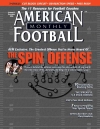AMERICAN FOOTBALL MONTHLY THE #1 RESOURCE FOR FOOTBALL COACHES
Article CategoriesAFM Magazine
|
AFM Subscribers Ask... Dan Hawkins© More from this issueWhat Division I-A program was the only school to average over 40 points a game in the period, 2000-2005? The answer is Boise State and for 5 of those 6 years Dan Hawkins was the head coach. His five-year 53-11 record included three 11-plus win seasons and 31-game winning streaks in both WAC play as well as at home on Boise State’s famous blue artificial turf field. Last December he was named the 23rd head coach in University of Colorado history. Now in his first year in Boulder, he answers your questions… Q. In going from Boise State to Colorado, what have been the biggest adjustments you’ve had to make as a head coach? Jason Streeter, Assistant Coach, Bluffton HS (IA). AFM subscriber since 2001. There really haven’t been many…the specific aspects of the job are the same. It’s obviously different than a program with recent success but the dynamic of the job is the same. Even dealing with the media is not that different; while at Boise, the national media – ESPN, Sports Illustrated, The New York Times – were a constant presence. Q. In the transition from the WAC to the Big-12, is there a difference in the level of athlete you’re coaching? Bob Conrad, Assistant Coach, Prairie HS, Stafford, SC. AFM subscriber since 2003. Generally, yes…to some degree, the athletes are somewhat bigger, faster, and stronger in the Big-12. But we had many athletes at BSU that could play in the Big-12 at just about every position. Q. What are some of the basic questions that a head coach should use each week with his staff to evaluate his team? Jerry Parrish, Secretary of the Washington State Coaches Association, North Kitsap High School (WA). AFM subscriber since 1997. We try to look at each play in all three phases of the game, and, more specifically, how we performed technically on each play. We also try to determine our strengths and weaknesses and break down specific assignments. As a staff, we also examine our schemes and whether we were successful and if we were on the right track. We also want to learn how we can get better in all phases of the game. I ask all of our coaches for their evaluation of their specific players. Q. You helped develop a prolific offense during your years at BSU…what are the elements necessary to do the same thing at Colorado? Steve Buren, Assistant Coach, St. James High School, MO. AFM subscriber since 2004. 1. It all starts with the offensive line…they have to have size, strength, experience and depth. If you’re not good with the O-line, more than likely you’re in trouble; 2. You have to have a quarterback who can process what you’re trying to teach. He has to be able to handle the pressure, know the reads, be accurate, smart, and a leader; 3. You also have to have a consistently strong running game. In evaluating quarterbacks, you want your athlete to be mechanically sound with good foot work. You, obviously, want him to be accurate as well which is very important. But if a QB is not mechanically sound, the 3-1 rule may come into play; that is, for every time a player does something wrong, it takes three times as long to correct it and relearn the proper mechanics. As a coach you can certainly help develop accuracy as well as defensive reads. I believe at this level the game is 80% mental and 20% physical for a quarterback. A QB must also be able to perform under pressure and help produce wins while hearing reaction from the fans and media. He also has to be tough and know he’s going to take a lot of hits. The QB also must be a leader and be able to audibilize and make the right play against the right defense. You can tell fairly soon after watching a QB perform whether or not he has a chance to develop and lead your team. Q. Are you a proponent of scripting plays at the start of a game and after halftime? Michael Morris, Head Coach, Rio Linda High School (CA). AFM subscriber since 1995. We usually script 15-20 plays at the start of a game but will change plays depending on down and instance. I feel it helps the team and gives them confidence in starting the game. We do the same thing coming out after halftime but with a smaller number of scripted plays. Q. What type of a goal line package do you run? Keith Akers, Bragg Middle School (AL). AFM subscriber since 2006. We usually go to a three tight end, two running backs package with variations depending on the defense. Q. Our team uses the 4-3 defense. What kind of talented personnel will be necessary to maximize the 3-3 stack defense? Also, what do you consider the most important attributes in a nose guard? Katsuji Ibaraki, Head Coach of the Korean national team, Osaka Sangyo University, Japan. AFM subscriber since 1998. The 3-3 stack is getting away from the 4-3 but, as a rule, it’s used because there aren’t a lot of big defensive linemen out there. So you use in a 3-3-5 a total of eight linebackers and defensive backs, generally faster and quicker players – to find gaps. The point is you want as much speed and aggressiveness as you can find. Ideally, the nose guard has to be a powerful defensive lineman, not necessarily that big, but must possess quick feet and be able to use his hands well. It’s a pretty special position and the NG must be quick as well. |
|
| HOME |
MAGAZINE |
SUBSCRIBE | ONLINE COLUMNISTS | COACHING VIDEOS |
Copyright 2024, AmericanFootballMonthly.com
All Rights Reserved




